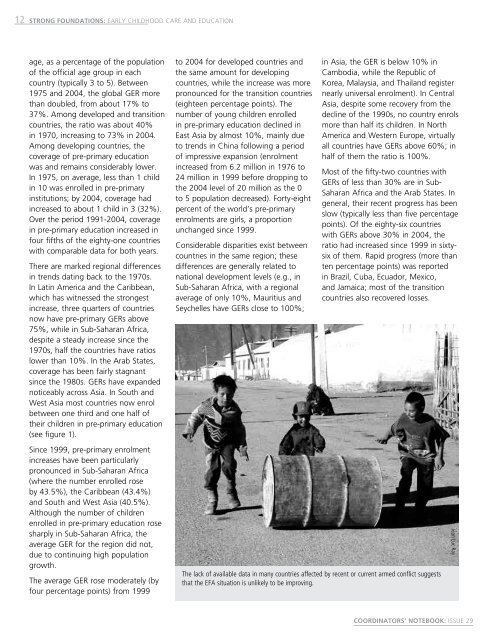A global call to action for early childhood
A global call to action for early childhood
A global call to action for early childhood
Create successful ePaper yourself
Turn your PDF publications into a flip-book with our unique Google optimized e-Paper software.
12 Strong foundations: Early <strong>childhood</strong> care and education<br />
age, as a percentage of the population<br />
of the official age group in each<br />
country (typi<strong>call</strong>y 3 <strong>to</strong> 5). Between<br />
1975 and 2004, the <strong>global</strong> GER more<br />
than doubled, from about 17% <strong>to</strong><br />
37%. Among developed and transition<br />
countries, the ratio was about 40%<br />
in 1970, increasing <strong>to</strong> 73% in 2004.<br />
Among developing countries, the<br />
coverage of pre-primary education<br />
was and remains considerably lower.<br />
In 1975, on average, less than 1 child<br />
in 10 was enrolled in pre-primary<br />
institutions; by 2004, coverage had<br />
increased <strong>to</strong> about 1 child in 3 (32%).<br />
Over the period 1991-2004, coverage<br />
in pre-primary education increased in<br />
four fifths of the eighty-one countries<br />
with comparable data <strong>for</strong> both years.<br />
There are marked regional differences<br />
in trends dating back <strong>to</strong> the 1970s.<br />
In Latin America and the Caribbean,<br />
which has witnessed the strongest<br />
increase, three quarters of countries<br />
now have pre-primary GERs above<br />
75%, while in Sub-Saharan Africa,<br />
despite a steady increase since the<br />
1970s, half the countries have ratios<br />
lower than 10%. In the Arab States,<br />
coverage has been fairly stagnant<br />
since the 1980s. GERs have expanded<br />
noticeably across Asia. In South and<br />
West Asia most countries now enrol<br />
between one third and one half of<br />
their children in pre-primary education<br />
(see figure 1).<br />
Since 1999, pre-primary enrolment<br />
increases have been particularly<br />
pronounced in Sub-Saharan Africa<br />
(where the number enrolled rose<br />
by 43.5%), the Caribbean (43.4%)<br />
and South and West Asia (40.5%).<br />
Although the number of children<br />
enrolled in pre-primary education rose<br />
sharply in Sub-Saharan Africa, the<br />
average GER <strong>for</strong> the region did not,<br />
due <strong>to</strong> continuing high population<br />
growth.<br />
The average GER rose moderately (by<br />
four percentage points) from 1999<br />
<strong>to</strong> 2004 <strong>for</strong> developed countries and<br />
the same amount <strong>for</strong> developing<br />
countries, while the increase was more<br />
pronounced <strong>for</strong> the transition countries<br />
(eighteen percentage points). The<br />
number of young children enrolled<br />
in pre-primary education declined in<br />
East Asia by almost 10%, mainly due<br />
<strong>to</strong> trends in China following a period<br />
of impressive expansion (enrolment<br />
increased from 6.2 million in 1976 <strong>to</strong><br />
24 million in 1999 be<strong>for</strong>e dropping <strong>to</strong><br />
the 2004 level of 20 million as the 0<br />
<strong>to</strong> 5 population decreased). Forty-eight<br />
percent of the world’s pre-primary<br />
enrolments are girls, a proportion<br />
unchanged since 1999.<br />
Considerable disparities exist between<br />
countries in the same region; these<br />
differences are generally related <strong>to</strong><br />
national development levels (e.g., in<br />
Sub-Saharan Africa, with a regional<br />
average of only 10%, Mauritius and<br />
Seychelles have GERs close <strong>to</strong> 100%;<br />
in Asia, the GER is below 10% in<br />
Cambodia, while the Republic of<br />
Korea, Malaysia, and Thailand register<br />
n<strong>early</strong> universal enrolment). In Central<br />
Asia, despite some recovery from the<br />
decline of the 1990s, no country enrols<br />
more than half its children. In North<br />
America and Western Europe, virtually<br />
all countries have GERs above 60%; in<br />
half of them the ratio is 100%.<br />
Most of the fifty-two countries with<br />
GERs of less than 30% are in Sub-<br />
Saharan Africa and the Arab States. In<br />
general, their recent progress has been<br />
slow (typi<strong>call</strong>y less than five percentage<br />
points). Of the eighty-six countries<br />
with GERs above 30% in 2004, the<br />
ratio had increased since 1999 in sixtysix<br />
of them. Rapid progress (more than<br />
ten percentage points) was reported<br />
in Brazil, Cuba, Ecuador, Mexico,<br />
and Jamaica; most of the transition<br />
countries also recovered losses.<br />
The lack of available data in many countries affected by recent or current armed conflict suggests<br />
that the EFA situation is unlikely <strong>to</strong> be improving.<br />
Jean Luc Ray<br />
COORDINATORS’ NOTEBOOK: ISSUE 29
















